Coral Sea Cruising Guide ~ Coral Sea Feature Film
A BOSS EXPEDITION
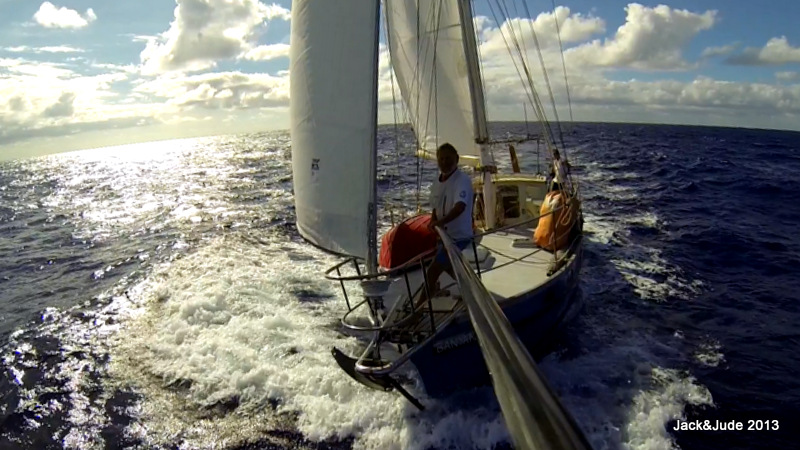 If we were union members, there’d not be enough money to pay us for the hardships and hard yakka we’ve endured these last five weeks. Nor would there be enough coin to buy the thrills and memories we experienced in those weeks in Nature’s kingdom.
If we were union members, there’d not be enough money to pay us for the hardships and hard yakka we’ve endured these last five weeks. Nor would there be enough coin to buy the thrills and memories we experienced in those weeks in Nature’s kingdom.
The good ship Banyandah is presently racing through the scantily sounded waters between Pandora Entrance and Torres Strait, blown by strong winds upwards of 33 knots according to the weathermen. An intense, nearly stationary high-pressure cell has driven us rocking and rolling these last seven days, ever since leaving East Diamond Islet, 600 nm ago.
Our last report saw us departing Ballina, Northern NSW under low grey clouds heralding a change. We were the last vessel out before the notorious Richmond River Bar closed our home port, just as it had been the previous two weeks. On that fortunate ‘one day’ we made our escape to sail north for warmer climes while it rained buckets and blew stinko back home.
Our mission: To explore Coral Sea reefs and islets, film their exotic beauty and wildlife, and compare from a layperson’s view any changes we perceived from our previous visits out there in the 70s and 80s. In winter, the SE trades are reinforced during June, July, and August. Be that as it may, we had our own time restraints and wanted to film the seabird winter breeding season. Therefore we decided to pray for the best and take what was given, knowing we’d be lucky to get ashore on a few of the exposed sand islets. Also knowing our expedition may only prove to be a rough, fast trip to Torres Strait.
We are delighted to report that providence smiled upon our venture. A more complete report, a cruising guide, and Feature Film of our great adventure will be forthcoming at a later date, but in a nutshell here is what we achieved:
CATO REEF
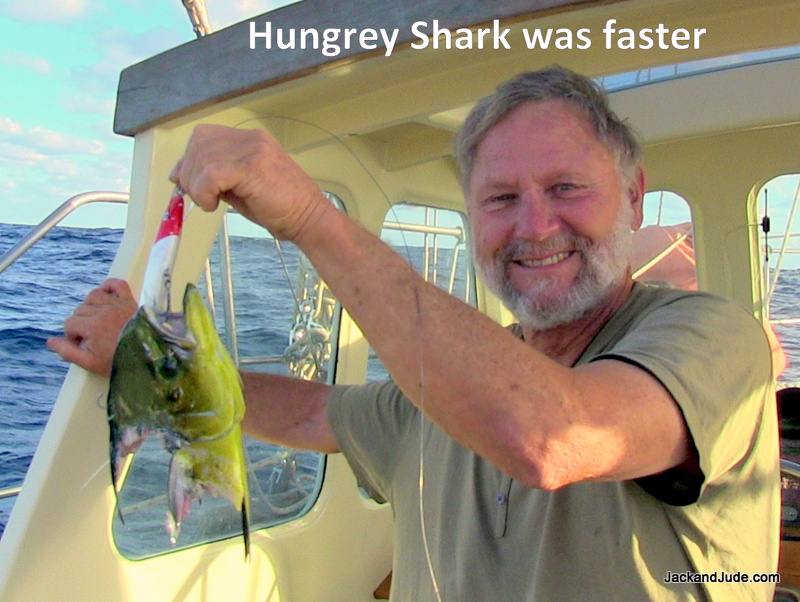 Ballina direct to Cato Reef, 380 nm took 72 hours. Nasty lumping conditions kept us from landing on this proclaimed Gay and Lesbian Kingdom. We surveyed two trade wind anchorages, both with boat channels leading into the lagoon and the island that’s extraordinary tall for a sand cay, 6 m above sea level and covered in grass and creepers up to 1 m high. A shiny metal building houses an automatic weather station. A large family of Common Noddies was observed.
Ballina direct to Cato Reef, 380 nm took 72 hours. Nasty lumping conditions kept us from landing on this proclaimed Gay and Lesbian Kingdom. We surveyed two trade wind anchorages, both with boat channels leading into the lagoon and the island that’s extraordinary tall for a sand cay, 6 m above sea level and covered in grass and creepers up to 1 m high. A shiny metal building houses an automatic weather station. A large family of Common Noddies was observed.
WRECK REEFS
An overnight sail took us to Wreck Reefs, 67 miles further north, where again we experienced poor conditions, too dangerous to dive on the historical wreck site of HMS Cato and Porpoise. On a dark, stormy August night in 1803, those ships ran onto heavily breaking reef, one ship following the other. Matthew Flinders was on board the Porpoise returning to England with his charts and logbooks. All his notes and specimens collected during his Australian circumnavigation were lost. Motoring over the exact spot, we peered into clear shallow depths while also keeping a steady eye on the huge winter swell rushing at us from southern storms. Early summer would be a better time to explore the wreck site.
Experiencing a light NE wind our first day, we anchored in a small sand patch 60’ deep off the far west end, half exposed to the southern swell and half exposed to the breeze. Then presto, a southerly the second day allowed us to explore the northern side of Porpoise Reef. To our great delight we found a niche bitten out the reef like a giant shark bite adjacent to the cay and sufficient to anchor Banyandah in 40’ coarse sand, coral heads on all sides except for the hundred metre wide entry. Well protected from trade winds, the water is nevertheless quite active, especially at high tide when waves pass over the reef and around the cay.
 We explored Porpoise Cay, 275 m long, 90 m wide and 3 m high which was vegetated with low grass and a succulent similar to Pig’s Face without pink flowers. White Masked Boobies were courting and nesting on its sandy fringe while brown Common Noddies nested within the foliage. About 20 pairs of Brown Boobies watched from the half tide rock on the windward edge. Pieces of black coal along the flotsam line lay amongst discarded bits of mankind’s plastic. And embedded in the congealed half tide rock, bits of metal were rusting away. The coal and metal very likely from the wrecks. Seeing these relics evoked a connection to that calamitous shipwreck and took our gaze to the foaming breakers where the fateful night enfolded. After striking, the “Porpoise took a fearful heel over on her larboard beam ends,” fortunately falling toward the reef so that her people were saved. The Cato, under Captain Park, struck about two cables away and “fell on her broadside,” her masts instantly disappearing. Several of the seamen were bruised against the coral rocks and three young lads were drowned. One of the poor boys had been shipwrecked no less than three times before—in every voyage that he had made—clung to a spar beside his captain and through the night wailed that he “was the persecuted Jonas who carried misfortune wherever he went.” Then, losing his hold among the breakers he was swept away and seen no more.
We explored Porpoise Cay, 275 m long, 90 m wide and 3 m high which was vegetated with low grass and a succulent similar to Pig’s Face without pink flowers. White Masked Boobies were courting and nesting on its sandy fringe while brown Common Noddies nested within the foliage. About 20 pairs of Brown Boobies watched from the half tide rock on the windward edge. Pieces of black coal along the flotsam line lay amongst discarded bits of mankind’s plastic. And embedded in the congealed half tide rock, bits of metal were rusting away. The coal and metal very likely from the wrecks. Seeing these relics evoked a connection to that calamitous shipwreck and took our gaze to the foaming breakers where the fateful night enfolded. After striking, the “Porpoise took a fearful heel over on her larboard beam ends,” fortunately falling toward the reef so that her people were saved. The Cato, under Captain Park, struck about two cables away and “fell on her broadside,” her masts instantly disappearing. Several of the seamen were bruised against the coral rocks and three young lads were drowned. One of the poor boys had been shipwrecked no less than three times before—in every voyage that he had made—clung to a spar beside his captain and through the night wailed that he “was the persecuted Jonas who carried misfortune wherever he went.” Then, losing his hold among the breakers he was swept away and seen no more.
KENN REEF
Another overnight passage took us 65 nm to Kenn Reef, where the lessening easterly breeze evaporated, leaving a blissful calm sea. Kenn Reef, located over 500 km from the Australian mainland, covers an area of approximately 40 km² that looks like a boot, 15 km in length with a maximum width of 8 km along the southern edge. The ankle or South Eastern Reef is the largest with three emergent sand cays on the SW part. The only permanent land, tiny Observatory Cay, about l00 m by 50 m and 2 m high has no vegetation. We found an excellent anchorage for all winds except northerlies with easy access to these cays from an extensive shallow patch over the purest white sand. But getting to this spot required careful visual navigation to avoid a large number of coral heads before passing over a shallow sand spit. But once in, we found Shangri-La. So much beauty floating on transparent blue running in all directions to deeper depths with slips of yellow white where brown clouds of seabirds noisily alight to circle in unison then settle briefly before taking flight again in recurring explosions of sight and sound.
MELLISH REEF
The 233 nm voyage to Australia’s furthest bit of real estate took 54 hours of easy sailing, landing a scrumptious Green Job fish just after sighting its white line of breakers. We’d been to this reef twice before, in ‘78 and ’82, and Mellish, lying about 1100 km east of Cairns was our main focus. Heralds’ Beacon, its sand cay 600 m by 120 m and rising just a few metres above the high-water mark was wildly active with clouds of seabirds as we anchored in 40’ fine coral sand near an above water coral boulder marking the boat channel into the lagoon. Banyandah had enough swinging room to a reef awash ahead with breaking coral patches well astern. At times, a nuisance southerly swell attacked our beam-ends, especially at low water, creating an uncomfortable roll.
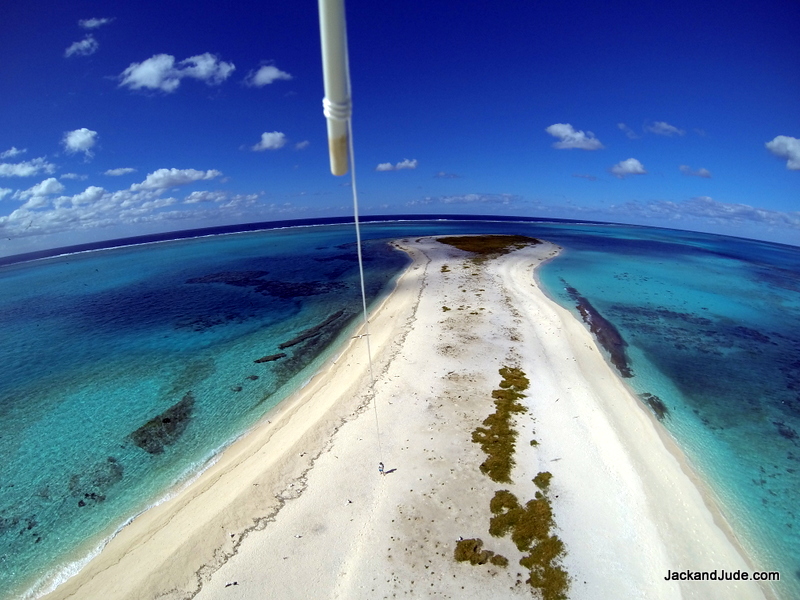 Our first footsteps on shore opened a floodgate of memories. We recalled ferrying base camp equipment and ham radio gear onto this very isolated sand islet that was devoid of all vegetation when last seen in 1982, a cyclone had devastated it, killing all the larger seabirds. Our hearts soared with what we were seeing now; a well-vegetated islet crowded with thousands of seabirds. Brown boobies filled the sky above us, while White Masked boobies bobbed their heads in courtship along the sandy fringe or sat upon eggs and frail featherless hatchlings. Several large brown patches of Common Noddies in their thousands chatted noisily along the yellow-white fringe. But in far greater numbers were Sooty Terns nesting in the low grassy vegetation. Upperparts black, white undersides, broad, triangular white forehead patch, black stripes across their eyes leading to a black nape. Our first rough estimate counted 15,000 birds, far greater than ever seen, and heart-warming realising that Nature can recover when left alone. Heartening also because food enough must exist in the surrounding seas to support so many creatures, which gives us hope that Earth can survive the human explosion.
Our first footsteps on shore opened a floodgate of memories. We recalled ferrying base camp equipment and ham radio gear onto this very isolated sand islet that was devoid of all vegetation when last seen in 1982, a cyclone had devastated it, killing all the larger seabirds. Our hearts soared with what we were seeing now; a well-vegetated islet crowded with thousands of seabirds. Brown boobies filled the sky above us, while White Masked boobies bobbed their heads in courtship along the sandy fringe or sat upon eggs and frail featherless hatchlings. Several large brown patches of Common Noddies in their thousands chatted noisily along the yellow-white fringe. But in far greater numbers were Sooty Terns nesting in the low grassy vegetation. Upperparts black, white undersides, broad, triangular white forehead patch, black stripes across their eyes leading to a black nape. Our first rough estimate counted 15,000 birds, far greater than ever seen, and heart-warming realising that Nature can recover when left alone. Heartening also because food enough must exist in the surrounding seas to support so many creatures, which gives us hope that Earth can survive the human explosion.
Our second day dawned grey and windless, perfect for our jaunt to the north end of the lagoon to look for the remains of the French warship Duroc, wrecked there in 1856. As if providence smiled upon us there was a negative tide at midday, perfect we thought to walk the seaward edge where we believe the Duroc had struck. She being a steam vessel we hoped to find her boiler or metalwork.
Imagine being 1100 km from help and piling into a ten foot tinny equipped with basic survival kit then powering 5 km away to explore a raw, exposed bit of Nature – just the two of us! Watching our treasured sanctuary grow smaller, we pondered what it must have been like for those unfortunate souls stranded on this reef over a hundred and fifty years ago. Three long boats had been immediately dispatched with 33 men to seek help from Copang, while the Captain, his wife and child remained on Heralds’ Beacon with about 40 men. For the next 50 days, exposed to the harshest conditions and suffering hunger, thirst, and sickness, they laboured building a 45’ boat that they named The Deliverance then set off for Timor. All survived.
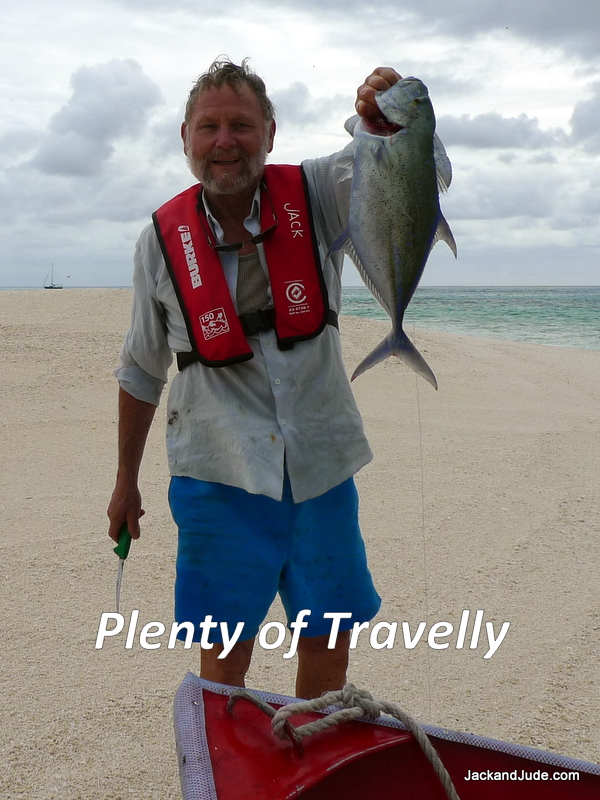 We easily found the rusting stern of a ship perched several hundred metres from the outer edge then came upon its bow section another few hundred metres further on. This we took to be the remains of a large fishing vessel near to where a cannon and fittings believed to be from the Duroc were found in 1977. Unfortunately the forecast negative tide did not expose the reef except for quite a number of lumps. This forced us into the water to make our search. We found plenty of manmade debris, but no boiler. What we found which might have come from the Duroc was solidly lodged in living coral and appeared to be part of a cooling column. From that position, an emerging cay of half tide rock lay exposed 500 metres into the lagoon, and Heralds’ Beacon glowed a welcome sight on the southern horizon.
We easily found the rusting stern of a ship perched several hundred metres from the outer edge then came upon its bow section another few hundred metres further on. This we took to be the remains of a large fishing vessel near to where a cannon and fittings believed to be from the Duroc were found in 1977. Unfortunately the forecast negative tide did not expose the reef except for quite a number of lumps. This forced us into the water to make our search. We found plenty of manmade debris, but no boiler. What we found which might have come from the Duroc was solidly lodged in living coral and appeared to be part of a cooling column. From that position, an emerging cay of half tide rock lay exposed 500 metres into the lagoon, and Heralds’ Beacon glowed a welcome sight on the southern horizon.
LIHOU REEF
After a wonderful eight days at Mellish, we set sail for Lihou Reefs 252 nm west using a light southwest wind that increased to 20 knots making our landfall rather bumpy. Lihou is a series of reefs connected by shallow, narrow passages, unsafe to enter. Our last night, hard on the wind with those reefs a dangerous lee shore getting closer as we aimed for the last reef, the crash and rumble robbed us of sleep.
Nicking into the lagoon through overfalls was exciting, but we could not find an anchorage close to a nearby sand islet, forcing us to anchor behind the main barrier reef a fair distance off. Exposed to both sea and wind, the Banyandah sat comfortably unaffected by current while she bobbed up and down in 2’ to 3’ swell. The islet too far away to entice a visit, we stayed the night then sailed on.
EAST DIAMOND ISLET
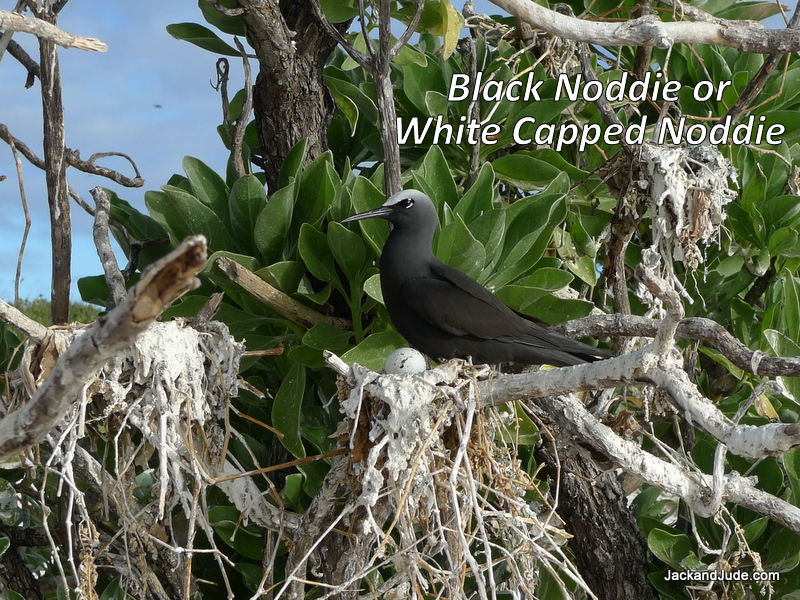 We had read on a Coral Sea fishing website that East Diamond Islet has a spectacular anchorage, and in photographs we saw bushes upon which several specie of seabirds nest, making East Diamond Islet much anticipated. Providence or good fortune had the breeze fade away at the end of the day sail from Lihou, and we motored into a well-protected anchorage bright with white sand. On the cay rose a light structure. Around it and above us, everywhere in fact, the air alive with many specie of seabirds featuring the most Frigatebirds we’ve ever seen. A 2006 report put the numbers at 2,500 Lesser Frigatebirds, a thousand pairs of Red-footed Boobies and very large numbers of Black and Common Noddies, Masked and Brown Boobies, Black-Naped Terns, Sooty Terns, Wedge-tailed Shearwaters, several Red-tailed Tropicbirds and a few Great Frigatebirds.
We had read on a Coral Sea fishing website that East Diamond Islet has a spectacular anchorage, and in photographs we saw bushes upon which several specie of seabirds nest, making East Diamond Islet much anticipated. Providence or good fortune had the breeze fade away at the end of the day sail from Lihou, and we motored into a well-protected anchorage bright with white sand. On the cay rose a light structure. Around it and above us, everywhere in fact, the air alive with many specie of seabirds featuring the most Frigatebirds we’ve ever seen. A 2006 report put the numbers at 2,500 Lesser Frigatebirds, a thousand pairs of Red-footed Boobies and very large numbers of Black and Common Noddies, Masked and Brown Boobies, Black-Naped Terns, Sooty Terns, Wedge-tailed Shearwaters, several Red-tailed Tropicbirds and a few Great Frigatebirds.
On shore several species were breeding, including the Frigatebirds and Red-footed Boobies, so our cameras rolled and clicked for the next five days. Climbing the light structure gave a whole new perspective, as did sending our GoPro aloft on the parafoil kite. And Jude was in heaven talking to all the creatures as we made a doco explaining the habits and features of each group.
After four weeks in the wild, as if on cue a new wind system arrived. Forecast strong winds sped us north for Torres Strait. Our “mainsail from hell” stayed aloft only until midnight when the wind reached 20 knots. After that, two headsails poled out kept Banyandah running straight as an arrow towards Pandora Entrance 550 nm NNW.
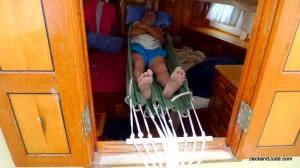 Every day we downloaded a new weather map via our HF and each day the high-pressure system grew more intense until on our third night we had 40 knots up our tail. Our windvane, Sir Aries, took it in his stride, so all we had to do was hang on and not get hurt. The hammock I made in Ballina proved a most valuable new addition. Strung between aft cabin bulkheads, once in, we could have been at home in bed and getting the rest so needed on heavy weather voyages.
Every day we downloaded a new weather map via our HF and each day the high-pressure system grew more intense until on our third night we had 40 knots up our tail. Our windvane, Sir Aries, took it in his stride, so all we had to do was hang on and not get hurt. The hammock I made in Ballina proved a most valuable new addition. Strung between aft cabin bulkheads, once in, we could have been at home in bed and getting the rest so needed on heavy weather voyages.
Four days, almost to the hour, traversed the 550 nm needed to escape the Coral Sea’s heavy seas, where rushing through a two mile gap in the Outer Barrier Reef at Pandora Entrance brought lesser seas and everywhere a mess of obstacles to dodge.
Jude loves her stats; in 35 days from Ballina, Banyandah made good 1730 nautical miles, anchoring 14 times at eight reefs, our new Manson anchor, The BOSS biting first time every time. We burnt a grand total of 50 litres of fuel and consumed 100 cans of beer and twelve bottles of wine. You’ve got to admit we’ve got our priorities right!
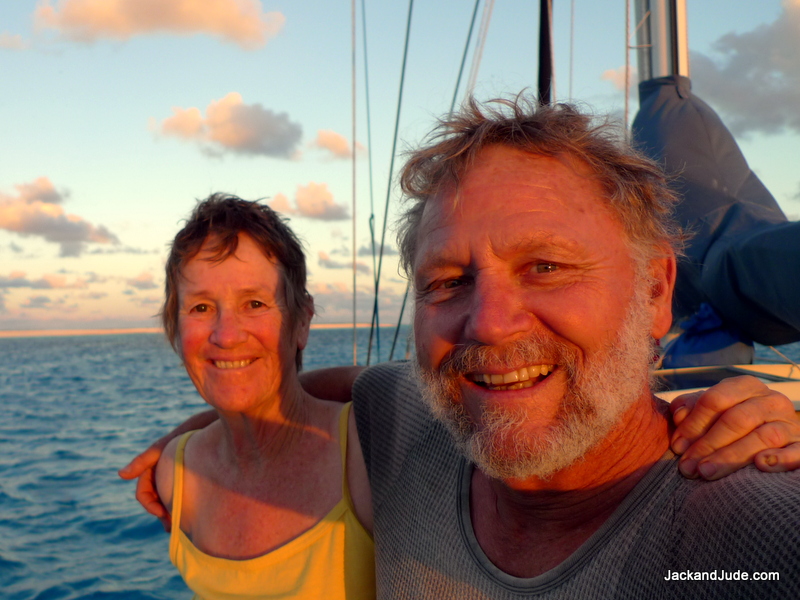
Now, it’s onwards to Darwin…..
Dream, Explore, Discover, and Stay Safe
Jack and Jude

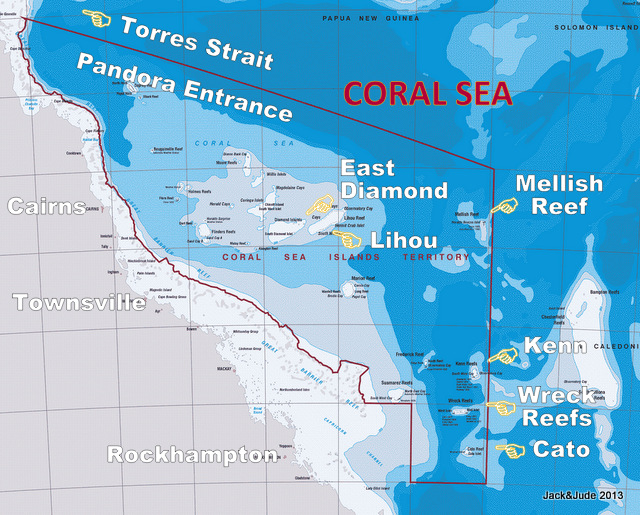

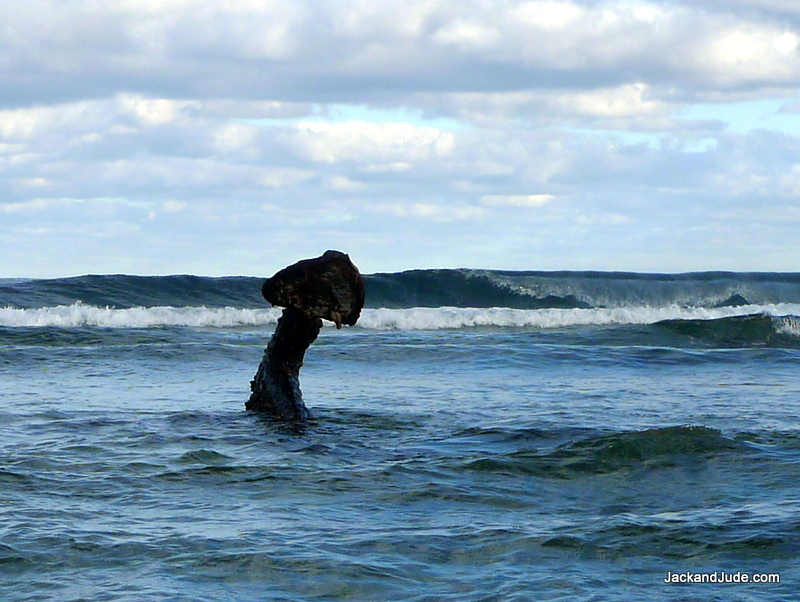

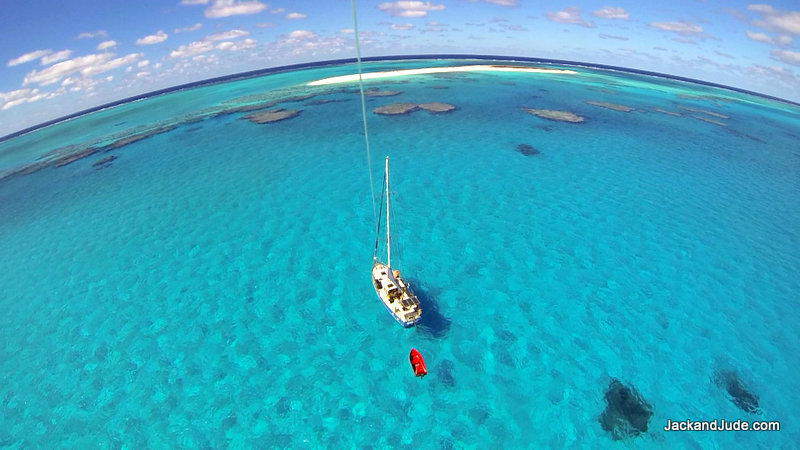

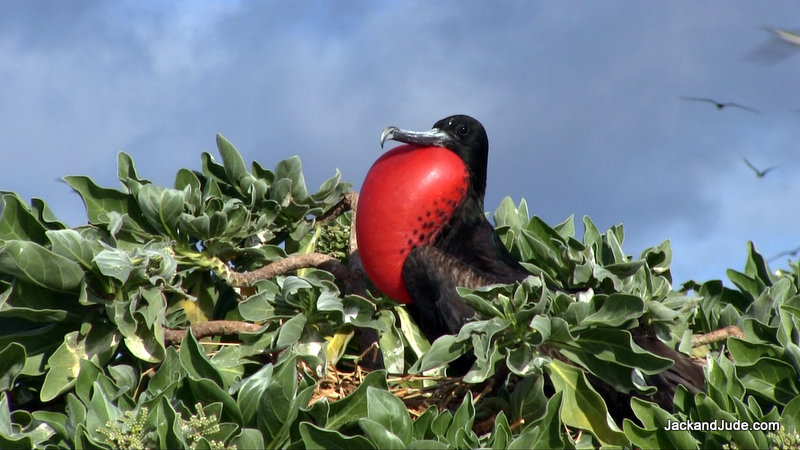
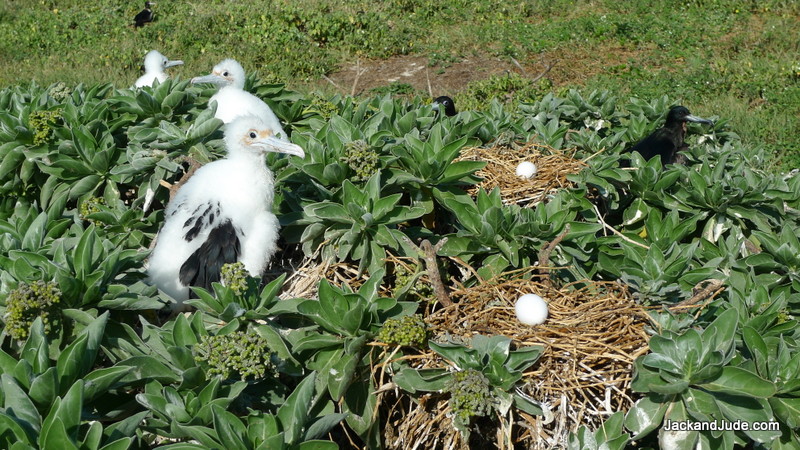
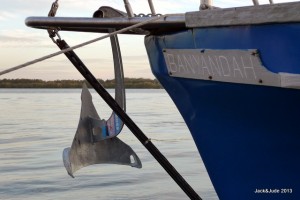
So good to follow you both on your latest trip. Very exciting and inspiring. Enjoy xxx
Lots of love Trish
Hi guys,
Great to hear from you. I loved reading the blog, once again and loved, loved the photos.
Much love and thoughts
V&D XX
Always a great read guys. I’m going to start watching your DVD’s very soon.
Ted